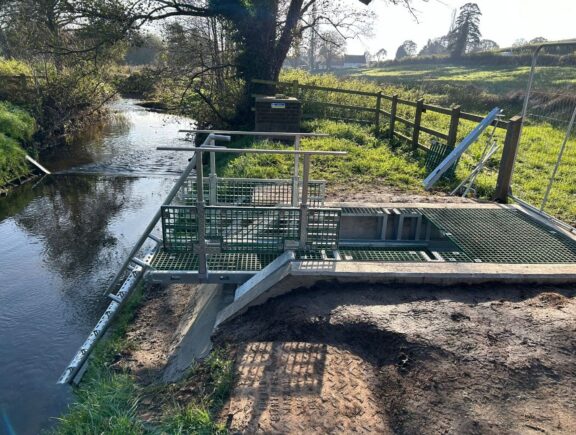Edge protection systems were installed along the weir to ensure the safety of the site team, who wore lifejackets at all times – in accordance with the company safety policy and the EA SHEW CoP – and were trained in swift water rescue techniques. In addition, a rescue davit system with fall arrest and retrieval capabilities was installed as a part of the rescue plan, and all site operatives were harnessed to this whilst working in the channel.
A temporary warning system was used upstream of the stop logs to activate an alarm when a predesignated water level was reached. This was required to alert the operatives that the area was no longer safe for works to be carried out.
Stop logs were inserted into the existing stop log channels, and a flexible waterproof liner was temporarily secured to the upstream face of the stop logs to reduce leakage. Once the flow reduced to a suitable level, temporary stairs were installed for safe access, and the existing footbridge over the channel was removed and stored for later reinstallation.
Prior to the works, a sandbag cofferdam was installed across the channel, and a submersible pump was used for dewatering the impounded work area. The pump remained in situ to ensure a dry working area throughout. Works were then carried out on one sluice at a time to ensure the other sluices could remain fully operational and the water levels and flow along the watercourse could be maintained.
The existing screens were dismantled in sections with all fixings being removed by hand or with the use of cordless tools. Each section was then lifted from the channel using a telehandler, with a crane hook and sling attachment. Once the screen was entirely removed, vegetation was cleared from the face of the culvert wall. The new penstock screens were then lowered into position, the new fixing points were drilled, and the fixing anchors were set in and tightened in line with the manufacturer’s guidelines.
To complete the works, operation equipment was installed onto the new screens, and the footbridge was reinstated in a new location. Each screen was then tested to ensure operation to the agreed parameters was achieved. Once the screens had been successfully tested, the sandbag cofferdam and temporary access stairs were removed. The temporary waterproof liner was also removed from the stop logs, which were then reset to achieve the desired flow through the channel.











